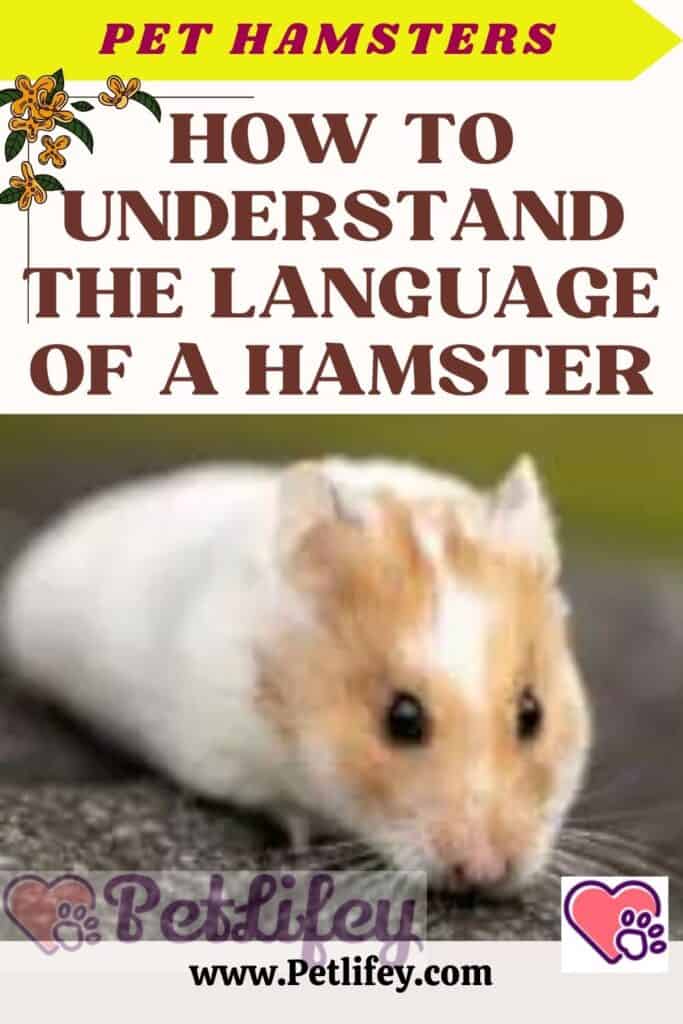
The hamsters are one of the rodent most preferred as pets . And no wonder! In addition to being tiny and adorable, they do not require great care and can bring love and happiness to the family . However, as with any other pet, you have to understand them. Many forget how important it is to know how the hamster communicates with people. Therefore, in this article, we are going to focus on that important issue.
The importance of understanding a the Hamster
As we said, many people who have pets forget how essential it is to understand the language of their companion animal.
Thanks to it we can know, for example, when a dog is preparing to attack, a cat is sad or a hamster may be scared, among other states.
It is not just about understanding that our pet is happy when we play with it. It is very important to understand everything, because if we do not understand how animals communicate with us, we will not be able to help them in situations of stress or sadness.
Animals communicate with us in various ways. In the case of hamster communication, we will have to look at three fundamental aspects to understand it. These are:
- The sounds it makes.
- Your body language.
- The trust you have with us.
Hamster communication with people
The hamster is a silent creature except in extreme situations. Hoarse sounds or whistles can be distress calls (pain following a fall, hamster trapped). So pay attention to the fearful cries of the hamster.
If you disturb him during his resting phase, he reacts with a lot of irritation, growls, threatens or leaps furiously out of his litter box to teach the spoiler a lesson . Due to its solitary life, the golden hamster’s expressiveness is particularly geared towards defense and attack.
Identify a behavior
In the wild, hamsters come into contact through certain movements and signals, thus indicating to their fellows their peaceful or aggressive intentions . Hamsters in captivity also communicate in this way. However, these small animals have only a limited repertoire of facial expressions and are hardly able to point out a lack of attention to us. They find themselves in a situation of complete dependence, dependent on our donations, which is why poor care or inappropriate treatment can cause behavioral abnormalities such as apathy or serious illness in them .
If you want to meet your hamster’s expectations , you need to interpret his movements and messages . Anyone who observes him closely on a regular basis will quickly understand his language and will be able to react accordingly. When a hamster in captivity is given proper care , it is satisfied, clear-headed and agile. The hamster’s expressions tell us about his state of mind, letting us know if he’s feeling comfortable, or if he’s upset and wants to be left alone.
What sounds do Hamsters Make
Grunts, growls : intimidation, aggression.
Cracking : threat of attack and preliminaries to mating.
Whistling : call for help in difficult situations or manifestations of a hungry newborn.
Screams : The hamster is beside himself if he has been disturbed without consideration during his period of sleep. The defeated animal also expresses its fear.
Yelping : fear, bickering, or warning if they simultaneously squeal their teeth.
Chattering teeth : a serious warning to his opponent; absolutely separate the hamsters.
If you hear teeth gnashing , your hamster feels threatened. It also indicates a feeling of threat if you breathe out as a kind of hiss or squeak.
A small soft beeps are a claim for a hamster to another so that it comes close, for example, when a mother calls her young. Also, if there are several together, they can squeak . In that case, they are simply communicating with each other.
The squawks, grunts and purrs intense are other ways that have hamsters to warn that they feel embarrassed and they need tranquility and space.
Understanding body language of Hamsters
Hamsters are belligerent and try to impress, especially when in the presence of fellow creatures. For these natural loners , a meeting between rivals fighting over territory and food ends in dangerous altercations. The pressure that ends up weighing on an animal without a preserve is considerable. If he senses the presence of an enemy, he becomes aggressive, with murderous instincts .
Even in captivity, two animals accustomed to each other first establish a hierarchical scale . Everyone claims the territory or wants to be the first to eat. If one of them wants to frighten his fellow creature, he pushes him away first with his front paws or plays the big tough ones by inflating his cheekbones in a threatening way. A scared and defeated opponent lies on his side, showing his submission . If he is courageous, the danger is real because the hamsters then fight and bite each other until they bleed. Ultimately, wherever they go, these quarrels cannot be avoided. Unlike us who seek companionship, the hamster doesn’t care.
- A happy hamster will jump and play.
- If your hamster is scared, it can hide by rolling into a ball or lying on its back.
- Compulsive cleaning or digging like crazy is also a sign of threat or fear.
- If your hamster bites the bars of his cage it can indicate stress, boredom, hunger or illness, among other reasons. None of them are positive.
- If the rodent is calmly cleaning its coat or stretching , you can ensure that it is happy.
- The yawns are also a sign of relaxation.
- When they are very afraid and feel that they need to start defending themselves, it is very normal to see them stretch their tails and fold their ears while they take great strides through the cage.
- If your hamster is normally allowed to be removed from the cage, but at one point it shows something elusive , better leave it. Maybe they want to rest, because you must remember that they are much more active animals at night than during the day.
- One way to show that you are alert and curious is to sit up on your hind legs, elevate your torso, and curl your front legs . However, raising their legs, but not remaining seated, is their way of defending themselves.
| Body Language | Meanings |
| Cheekbones and erect ears | The hamster wants to make an impression and threaten |
| Arched body and raised rear end | The female is ready for mating |
| Body lowered, flattened against the ground | Fear, shyness |
| Hamster standing on hind legs | Curiosity, attention, restlessness |
| Hanging front legs, one lower than the other | security |
| Hamster sitting on hindquarters, paws hanging down | Safety, calm |
| Stiffness | Insecurity, smelled an opponent |
| Extended toilet | Thorough body care |
| Running on the hind legs, hindquarters raised and head down | Submissive attitude of young people towards adult hamsters |
| Abrupt toilet | Fright, substitute activity in conflict situations |
| Toilet and caress between two hamsters | Marks of affection between a male and a female |
| On the back, play dead | Terror, submission |
| Jumps, leaps | Arrogance |
| Stretching, yawning | Just awake, even mood |
| Walk with grazing sides | Marks its territory, takes possession of it |
| Apathy | Boredom, sickness |
| Front leg lift | The hamster repels the attack of a female |
| Escape due to chase or assault | He defends himself, saves himself |
| Hamster showing its sharp teeth | Demonstration of strength, expression of one’s biting abilities |
| Ears back | Fatigue, fear, aggression, defense |
| Thrills | Fear |
| He is thinning, lacking in spirit, his coat is dull, his eyes inflamed. | I am sick or old. |
| He lies on his back and bares his teeth. | I have little ; if I am touched, I will have to defend myself. |
| It slips away when you stroke it. | I have enough. |
| He feverishly transports materials to his nest. | I’m going to have babies, I need to be left alone. |
| He yawns. | I have a pleasant desire to sleep, I feel completely at my ease. |
| He takes pleasure in grooming, rummages in his litter, carries food, capers in the cage with agility. | I feel good. |
| He is irritated. | I cannot sleep in peace, I am hugged too often. |
| He growls, growls or yelp. | I would like to be left alone. |
| He makes the beautiful, the interesting. | I discovered something. |
| He is amorphous, unresponsive. | I’m bored, I need a distraction. |
| He jumps. | A noise scared me. |
Trust with humans
Another way you have to understand your hamster is to see how it behaves when it is close to you.
- If you approach the cage and it goes to the area closest to you , it is because it is very fond of you.
- On the contrary, if he flees into a corner and tries to hide, he does not want human company. If this is the case, it is best to offer him a hamster treat in your hand and let him come closer to gain security.
- Also, if the hamster eats in front of you, it means that he feels good about your presence.
The best thing is that you get used to the animal from small to your contact. You can start in the aforementioned way: attracting him with a prize. Once it is in your hand, hold it so it does not fall, but be careful not to squeeze too much.
Stroke him gently and speak calmly , let him stay with your tone of voice. This will reassure you if you find yourself nervous at any later time.
If you have your hamster on top and play to get into your pocket or through the sleeve of your shirt, it is because it adores you and wants to be with you.
Take care of your hamster!

Now that you have the keys to understanding your hamster, you can pay more attention to them to understand it. But understanding alone is not enough, you must know how to respond to what your pet tells you.
If the hamster demands your affection, give it to him. If he needs space, allow him to be alone and quiet. Don’t get angry, yell at him or force him out of the cage if he doesn’t want to. And of course, remember to explain to all family members what are the signals that the animal sends so that everyone can understand it and take care of it as it deserves.






